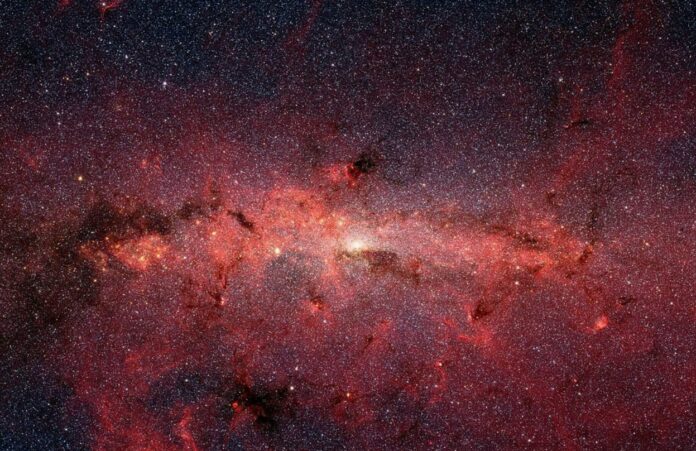These new “findings may just change the view on what ingredients we have in the first place to form new stars and new planets,” remark the authors.
Researchers from an international team have discovered a potential crucial stage in the chemical development of molecules in “stellar nurseries” in space.
Trillions of molecules have been swirling together for millions of years in these enormous clouds of frigid gas and dust in space. When these clouds between the stars fall apart, new stars and planets are born.
Stellar nurseries are rich in organic molecules, which are mostly composed of carbon and hydrogen atoms, much like human bodies.
The research team’s findings, which were published today in the journal Nature Astronomy, show how certain massive organic molecules may originate within these clouds.
It’s only one little step in the eons-long chemical journey that carbon atoms take, beginning in the hearts of dead stars and progressing to planets, living things on Earth, and maybe beyond, “creating the first building blocks that will, in the end, form stars and planets,” according to research associate Jordy Bouwman from Atmospheric and Space Physics (LASP) at the University of Colorado Boulder
In the current research, Bouwman and his colleagues focused particularly on a one-star nursery: the Taurus Molecular Cloud (TMC-1).
It is approximately 440 light-years (more than 2 quadrillion miles) away from Earth and is located in the constellation Taurus. Astronomers refer to this chemically complicated environment as an “accreting starless core.”
Although its cloud has started to disintegrate, no signs of developing stars have been seen there as of yet.
The team’s conclusions are based on the deceptively simple chemical ortho-benzyne. The researchers demonstrated that this molecule may easily mix with other molecules in space to produce a variety of bigger organic compounds using tests on Earth and computer simulations.
In other words, small building blocks grow into large building blocks.
These responses, according to Bouwman, may indicate that star nurseries are far more fascinating than has been previously thought.
“We’re only at the start of truly understanding how we go from these small building blocks to larger molecules,” he adds. “I think we’ll find that this chemistry is so much more complex than we thought, even at the earliest stages of star formation.”
Bouwman is a cosmochemist, a researcher who combines chemistry and astronomy to better comprehend the churning chemical processes that occur deep in space.
He noted that at first glance, cool molecular clouds may not seem to be teeming with chemical activity. These cosmic primordial soups, as their name implies, are often icy, frequently hovering about -263 degrees Celsius (or -440 degrees Fahrenheit), only 10 degrees above absolute zero. To start, most reactions need at least a little amount of heat.
Whether it is frigid outside or not, star nurseries seem to be the site of complicated chemistry. Particularly in TMC-1, unexpectedly high levels of rather big chemical compounds with names like fulvenallene and 1- and 2-ethynylcyclopentadiene are present. Each of these compounds has a pentagonal ring of carbon atoms, therefore chemists refer to them as “five-membered ring compounds.”
It was unknown where these molecules came from, but scientists continued finding them in TMC-1, according to Bouwman.
They believe they have solved the issue now.
Using the Yebes 40-meter Radiotelescope in Spain, scientists discovered the unanticipated chemical ortho-benzyne in the gaseous clouds of TMC-1 in 2021.
This tiny molecule, which consists of a ring of six carbon atoms and four hydrogen atoms, is one of the extroverts of the chemical world, according to Bouwman. It interacts with many different molecules without difficulty and doesn’t need a lot of heat.
“There’s no barrier to reaction,” Bouwman points out. “That means that it has the potential to drive complex chemistry in cold environments.”
Bouwman and his team of scientists from the US, Germany, the Netherlands, and Switzerland used a method called “photoelectron photoion coincidence spectroscopy” to figure out what kind of complex chemistry was progressing in TMC-1.
The team used light from a huge machine called a synchrotron light source to figure out what happened when chemicals were mixed.
They observed that ortho-benzyne and methyl radicals, frequent components of molecular clouds, easily combine to create larger and more intricate organic compounds.
“We knew we were onto something good,” adds Bouwman.
After that, the group turned to computer models in order to investigate the part that ortho-benzyne plays in a stellar nursery that spans several light years and is located deep inside space. The outcomes were encouraging: The simulations produced gas clouds that included a similar mixture of organic compounds to what astronomers have seen in TMC-1 via telescopes.
In other words, ortho-benzyne seems to be a strong candidate for driving the gas-phase chemical chemistry that takes place in these star nurseries, according to Bouwman.
In order to properly comprehend all the processes taking place in TMC-1, he said, there is still a lot of work for scientists to undertake. He wants to investigate, for example, how nitrogen atoms, which are crucial for the formation of DNA and amino acids in living things on Earth, are likewise taken up by organic molecules in space.
“Our findings may just change the view on what ingredients we have in the first place to form new stars and new planets,” comments Bouwman.
Source: 10.1038/s41550-023-01893-2
Image Credit: NASA Vie Getty
